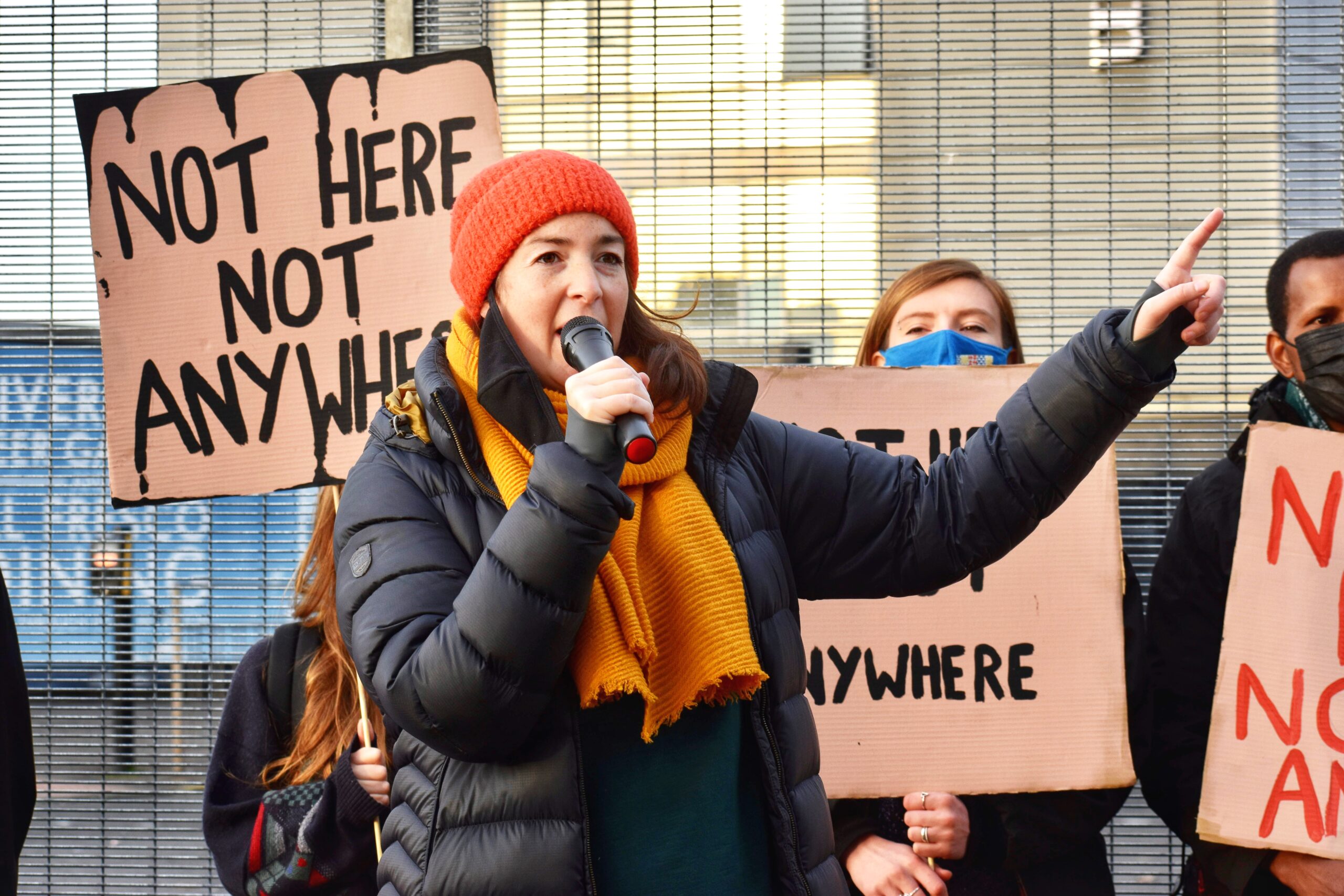
NPF4 and Climate Emergency: our priorities and how to get involved
The Scottish Government is preparing a new National Planning Framework. We have to make sure it helps us tackle the climate emergency, reduce air pollution and reach a circular economy
Along with the now delayed Climate Change Plan and the upcoming
Energy Strategy review, National Planning Framework 4 is going to be
absolutely central to our fight to tackle the climate emergency and
build the better world we know is possible.
As the strategic spatial vision for the next decade, NPF4 has the potential to lock-in dirty fossil fuel developments and business-as-usual or it could pave the way forward for a clean energy powered, re-localised economy, and healthy, thriving communities living in balance with nature.
That’s why it is so important that we engage with this crucial process at an early stage. This NPF will be looking towards 2050, setting national policies and developments and planning for regional and local spatial priorities.
Climate Emergency and NPF4: Our Priorities
Last year the First Minister declared a climate emergency and the Scottish Parliament passed a new Climate Change Act which set stronger, legally binding targets of a 75% reduction in greenhouse gas emissions by 2030 (on 1990 levels) and reaching net-zero emissions by 2045.
The climate crisis is deepening, and with Scotland set to host the UN Climate Summit COP26 in 2021, it is time for the Scottish Government to set out its plans for delivering on these commitments. Alongside the revised Climate Change Plan and Energy Strategy, NPF4 is a central pillar of the Scottish Government’s response to the climate emergency.
Following the passing of the Planning (Scotland) Act 2019, the next NPF will now cover a ten year period – the decade which the IPCC has identified as the crucial period for tackling the climate crisis if we are to succeed in limiting global temperature rise to 1.5C. Substantial changes to planning policy are required to meet our new climate targets and accelerate Scotland’s transition away from fossil fuels towards a 100% renewable, nuclear free, future.
There should be a requirement to consider the climate impact of every development in the planning system, beyond just energy generation projects, including at local planning authority level. The necessary guidance and resources must be created to support decision makers in this assessment.
Announcing the 2019 Programme for Government, the First Minister highlighted that “the global climate emergency means that the time is right for wide-ranging debate on more radical planning policy options” and the need for planning policy to “more radically reduce emissions”. NPF4 needs to create the framework for that radical reduction in emissions in every area.
Energy Developments
Current policy states that “the planning system should recognise the national benefit of indigineous coal, oil and gas production in maintaining a diverse energy mix and improving energy security.” This statement is outdated and planning policy must now be amended to reflect the climate emergency which the First Minister has declared and which the Scottish Government has committed to tackling.
For the planning system to support the national objective of delivering net-zero greenhouse gas emissions by 2045, NPF4 must signal the end for fossil fuel developments in Scotland and instead create an enabling framework for full deployment of a renewables mix across Scotland, including energy storage and community renewable energy projects.
In order to transition away from burning fossil fuels in heat and transport, there will be greater reliance on electrification in these sectors in the future. The UK Committee on Climate Change (UKCCC) has suggested that renewable electricity generation must quadruple in order to meet the new climate targets. NPF4 must enable a rapid scaling up of renewable electricity generation in Scotland over the next decade.
It should also be noted that the Government has committed to reviewing Scotland’s Energy Strategy in light of the new climate targets, and has indicated that the current target for 50% of Scotland’s total energy consumption across electricity, heat and transport to be met by renewables, will have to be strengthened. This places an ever greater emphasis on the role of planning policy in enabling the transition to a fully renewable energy system, and will require greater alignment of NPF and Scotland’s Energy Strategy.

A ban on all new fossil fuel developments
Fossil fuels drive the climate crisis and are responsible for the vast majority of Scotland’s greenhouse gas emissions. Any fossil fuel energy generation developments granted during the period of NPF4 would still be operating by 2045, the date by which Scotland must reach net-zero emissions, thereby locking us into a high carbon future and compromising our ability to meet the targets.
For the National Planning Framework to enable Scotland to reach net-zero emissions, it must include a ban on new fossil fuel developments. This should extend to all new coal, oil or gas energy generation developments, including projects below 50MW for which approval is currently granted by local planning authorities.
It must also include a ban on developments proposing to manufacture fossil hydrogen, meaning hydrogen from a fossil fuel source such as North Sea gas. Finally, this must be a complete ban, with no loopholes or exemptions for fossil fuel generation with Carbon Capture and Storage (CCS).
Clearly this would include a rejection of current proposals to build a new Liquified Natural Gas (LNG) terminal and Combined Cycle Gas Turbine power station at Hunterston.
Renewables as a national priority
The focus of the NPF, as with the Scottish Government’s climate and energy policy, must be on supporting the full deployment of renewable energies including wind, solar, tidal generation and a range of storage solutions including battery storage and pumped hydro.
The new framework must create a favourable planning regime for the roll out of renewable heating and heat networks at scale across Scotland,. New developments must be required to install renewable heating instead of fossil fuelled heating systems, in line with the Government’s commitment to phase out fossil fuel heating in new developments given consent after 2024.
The NPF must also create conditions favourable to community energy projects, in order to meet the Scottish Government’s target of achieving 2GW of community and locally owned energy by 2030. This must be accompanied by resources and guidance for local planning authorities.
Finally, large biomass plants should not be considered or included as renewable generation.
Strengthen the Moratorium on Fracking
NPF4 should include the Scottish Government’s position of no support for onshore unconventional oil and gas (fracking). The Scottish Government committed to doing this in October 2017 in a Scottish Parliament debate on the ‘preferred policy position’ on fracking. The Government subsequently confirmed, on announcing its final decision of no support for fracking in October 2019, that it would implement the indefinite moratorium using policy levers, including the NPF.
The NPF should strengthen the Government’s previous language to increase clarity around the position. Additionally, the present moratorium is limited to unconventional oil and gas extraction, therefore it may be worth exploring the possibility of strengthening the language in the NPF to include conventional onshore oil and gas extraction.

Tackle Air Pollution
Road transport is Scotland’s biggest climate polluting sector. Greenhouse gas emissions from transport made up 37% of Scotland’s total emissions in 2017, and total transport emissions are up on the 1990 baseline, while they’ve decreased in every other sector. Air pollution, which is primarily from transport, is responsible for the early deaths of 2,500 people in Scotland each year, and is linked to heart attacks, strokes, and respiratory problems, with children and the elderly amongst the worst affected.
Despite this, seven sites in Scotland are still exceeding air quality legal limits. The NPF must make reducing air pollution, particularly from transport, as one of the key principles of future planning decisions.
Planning has a huge role to play in changing the way we move around, and prioritising sustainable transport. We need to see an end to developments, both commercial and residential, that rely on, or assume, widespread car ownership. Developers must have a responsibility to extend the network of segregated cycling, ensuring safe cycling is a viable option. To help ensure an end to fossil fuel transport, electric vehicle charging points must be essential components for any parking proposals.
Moving to a circular economy
By 2050, Scotland should have moved from its current linear economy model to a circular economy where products are designed to last as long as possible, are easy to repair and made out of materials that can be recycled repeatedly. As Scotland moves to divert waste from landfill ahead of the ban on biodegradable waste to landfill coming into force in 2025, NPF4 must ensure we don’t see a rush to build more polluting incinerators to deal with the waste, but instead supports measures to reduce waste. The NPF must also help embed circular economy principles into the project and design processes for the whole lifecycle of a building or other construction which prioritise high rates of recycling, reuse and repair, and ensure that our rural, urban and coastal communities are clean and free of waste.
How to get involved at this stage
The Scottish Government has issued a “Call For Ideas” with a deadline of 30th April. They will use this to find out what people would like to see, and what they don’t want to see, in the planning framework. It’s an important opportunity for people and communities to put forward their ideas and outline what they would like to see – so make sure you have your say !
At this stage, the Scottish Government are asking the following five questions:
1. What development will we need to address climate change?
2. How can planning best support our quality of life, health and wellbeing in the future?
3. What does planning need to do to enable development & investment in our economy to benefit everyone?
4. How can planning improve, protect and strengthen the special character of our places?
5. What infrastructure do we need to plan and build to realise our long term aspirations?
However, these questions are there to help guide you but by no means are the only format you can give feedback. If these prompts don’t feel helpful or feel limiting you do not have to use them. Tell them whatever you think is important!
We are creating resources to help people respond to the Call for Ideas. Keep an eye on the website or contact activism@foe.scot to be emailed a copy.
Friends of the Earth Scotland will be submitting our own response to the Call for Ideas, which will be available on our website in due course.
The responses to these questions and any further comments can then be sent to scotplan@gov.scot and must be returned with a completed Respondent Information Form. Further updates on the process can also be found on the Planning and Architecture Blog.
Extra Resources
A more detailed overview which helps with prompts on how to complete this process and answer these questions can be found in the NPF4 informational video and is also outlined in the call for ideas step by step guide. The 2050 Think Pieces section on the Transforming Planning website also provides examples of what other people want to see.
- More detailed information about NPF4 and the previous planning frameworks can be found in the Programme of Engagement and on the Transforming planning website.
- Scottish Planning Policy and Planning Advice Notes (under current Planning regime)
- Follow on Twitter: @ScotGovPlanning #scotplan
